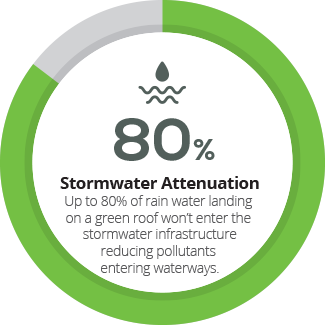Stormwater Management & Rainwater Retention
Green roofs reduce rainwater run off by a number of processes:
- Retention of the rainwater in substrate and drainage layers.
- Uptake and release of water from the substrate by the plant layer. Water is transported from the root to the leaf and lost through the leaf surface – a process known as transpiration.
- Solar driven evaporation of water from the substrate.
- Wind disruption of the still, humid air layer (known as the boundary layer) over the plants and substrate increasing the rate by which water is lost to the atmosphere through evaporation and transpiration.
The ideal solution would be to control water run off at source. However, it is difficult to install containment measures within the urban area where space is at such a premium. Roof planting offers what may be the only real solution.
In addition, vegetation and substrate can absorb a range of pollutants including nitrogen, phosphorus and heavy metals such as cadmium, copper, lead and zinc. This ensures that rainwater is filtered for pollutants BEFORE entering the stormwater system.
This is also useful when the rainwater is collected from the roof in rainwater tanks for use within the building. The rainwater collected will have been through a filtration process on the roof before it is stored.
In many cities around the world it has been recognised that the most significant ecological advantage of roof planting is storm water management. It is hard to come up with average figures of performance, however, roughly 50-60% of rainfall can be expected to be retained by an extensive green roof. Trials carried out at Trent University in Nottingham found that roofs fitted with a vegetation layer growing on a lightweight aggregate substrate layer considerably reduced the volume of rainwater discharged. Expressed as a percentage of the unplanted control roof, the planted roof retained 100% of a 3 mm rainfall, 80% of a 3-23 mm rainfall and for one period where 41mm of rain fell over 47 hrs, 73% of the rain was retained. Obviously, the planted roof is not designed to act as a sponge and eventually the roof will become saturated and discharge water.
Obtaining definitive figures for rainfall retention and discharge rates is difficult because trial observations are affected by a number of factors:
- The water status of the system prior to the rainfall. How much water is in the system at the start of any rainfall event will have a direct effect on the quantity of water retained during that event.
- How well established the vegetation layer is. The root systems of plants can retain very significant amounts of water. Shoot systems can take up and transpire (lose) very large quantities of water. A newly installed planted roof will not retain as much water as an established roof.
- The intensity of the rainfall. The ability of the planted roof system to retain water will be different for a long period of gentle rain compared to a short period of torrential rain.
- The season. Evaporation of water from the substrate and transpirational loss from the vegetation layer will be much greater in the summer due to the higher temperature and increased plant growth.
- The pitch of the roof. The greater the roof pitch, the less water is retained.
- The species of plants that make up the vegetation layer. The capacity to take up and transpire water will vary from species to species and also with season.
Trials we have carried out on our own systems indicate that between 40-60% of rainfall is retained and the run off time of the remainder is greatly extended. We are continuing to research the effects of the above factors and investigate methods of optimising this aspect of the system taking into account other factors such as weight and plant performance.
Urban & Climatic Improvement Climate Change Insulation

